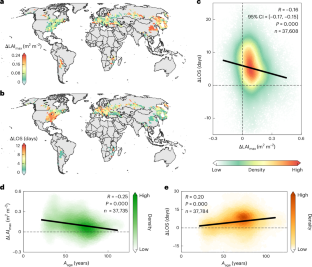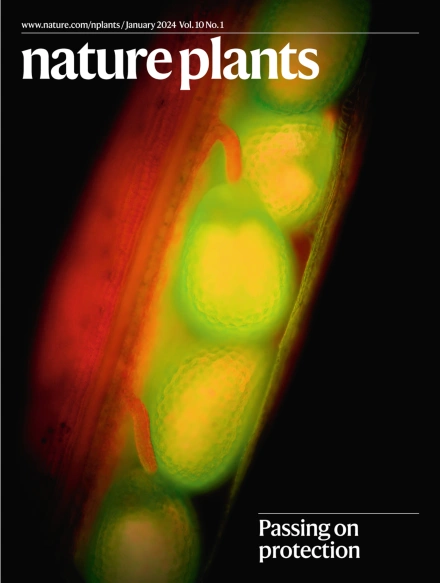不同年龄叶片适应策略对中高纬度落叶阔叶林植被绿化的影响
IF 13.6
1区 生物学
Q1 PLANT SCIENCES
引用次数: 0
摘要
增加叶面积和延长植被生长季节是全球绿化的两个主要驱动因素,已成为对气候变化的最显著响应之一。然而,目前尚不清楚这两种叶片适应策略在大空间尺度上如何在森林中变化。利用多个卫星数据集和野外测量数据,分析了2002 - 2021年中高纬度落叶阔叶林最大叶面积指数(LAImax)和生长季节长度(LOS)的时间变化(Δ)。与广泛持有的协调假设相反,我们的结果揭示了ΔLAImax和ΔLOS之间的负相关。值得注意的是,ΔLAImax和ΔLOS之间的权衡可以用林龄来解释。较年轻的dbf,基线LAImax较低,主要位于东亚,其LAImax增加,而LOS变化较小。这种获取策略有利于较年轻的dbf生长出光合效率更高、单位面积叶质量更低的叶片,从而提高了它们的光能利用效率。相反,基线limmax较高的老dbf(主要位于北美和欧洲)通过增加每面积叶质量来延长其limmax。这种保守的策略促使较老的dbf产生较厚但光合效率较低的叶片,导致光利用效率降低。我们的发现为叶面积和生长季节长度的差异变化提供了新的见解,并突出了它们对生态系统功能的不同影响。本文章由计算机程序翻译,如有差异,请以英文原文为准。


Contrasting age-dependent leaf acclimation strategies drive vegetation greening across deciduous broadleaf forests in mid- to high latitudes
Increasing leaf area and extending vegetation growing seasons are two primary drivers of global greening, which has emerged as one of the most significant responses to climate change. However, it remains unclear how these two leaf acclimation strategies would vary across forests at a large spatial scale. Here, using multiple satellite-based datasets and field measurements, we analysed the temporal changes (Δ) in maximal leaf area index (LAImax) and length of the growing season (LOS) from 2002 to 2021 across deciduous broadleaf forests (DBFs) in the middle to high latitudes. Contrary to the widely held assumption of coordination, our results revealed a negative correlation between ΔLAImax and ΔLOS. Notably, the trade-offs between ΔLAImax and ΔLOS were strongly explained by stand age. Younger DBFs, with lower baseline LAImax, predominantly located in eastern Asia, displayed an increase in LAImax with small changes in LOS. This acquisitive strategy facilitated younger DBFs to grow more photosynthetically efficient leaves with low leaf mass per area, enhancing their light use efficiency. Conversely, older DBFs with a higher baseline LAImax, primarily located in North America and Europe, extended their LOS by increasing leaf mass per area. This conservative strategy facilitated older DBFs to produce thicker, but less photosynthetically efficient leaves, resulting in decreased light use efficiency. Our findings offer new insights into the contrasting changes in leaf area and growing season length and highlight their divergent impacts on ecosystem functioning. This study reports age-dependent negative correlations between temporal changes in maximal leaf area index and growing season length, indicating contrasting leaf acclimation strategies driving vegetation greening in young versus old deciduous broadleaf forests.
求助全文
通过发布文献求助,成功后即可免费获取论文全文。
去求助
来源期刊

Nature Plants
PLANT SCIENCES-
CiteScore
25.30
自引率
2.20%
发文量
196
期刊介绍:
Nature Plants is an online-only, monthly journal publishing the best research on plants — from their evolution, development, metabolism and environmental interactions to their societal significance.
 求助内容:
求助内容: 应助结果提醒方式:
应助结果提醒方式:


